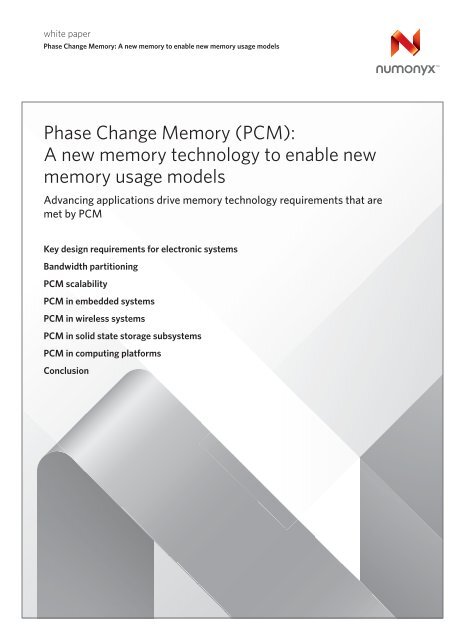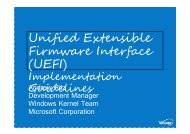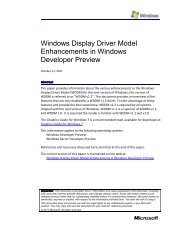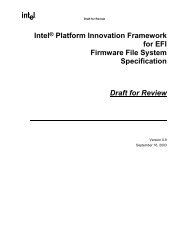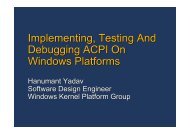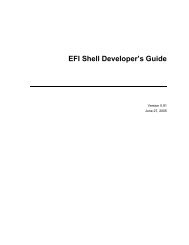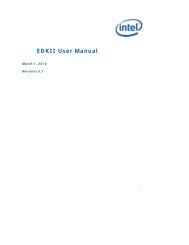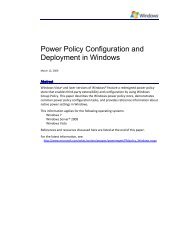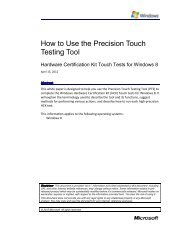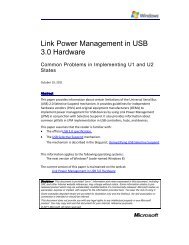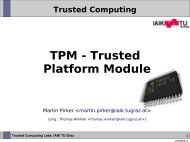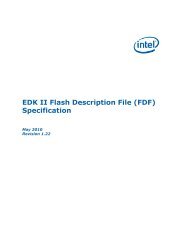Phase Change Memory (PCM): A new memory technology to enable ...
Phase Change Memory (PCM): A new memory technology to enable ...
Phase Change Memory (PCM): A new memory technology to enable ...
You also want an ePaper? Increase the reach of your titles
YUMPU automatically turns print PDFs into web optimized ePapers that Google loves.
white paper<br />
<strong>Phase</strong> <strong>Change</strong> <strong>Memory</strong>: A <strong>new</strong> <strong>memory</strong> <strong>to</strong> <strong>enable</strong> <strong>new</strong> <strong>memory</strong> usage models<br />
<strong>Phase</strong> <strong>Change</strong> <strong>Memory</strong> (<strong>PCM</strong>):<br />
A <strong>new</strong> <strong>memory</strong> <strong>technology</strong> <strong>to</strong> <strong>enable</strong> <strong>new</strong><br />
<strong>memory</strong> usage models<br />
Advancing applications drive <strong>memory</strong> <strong>technology</strong> requirements that are<br />
met by <strong>PCM</strong><br />
Key design requirements for electronic systems<br />
Bandwidth partitioning<br />
<strong>PCM</strong> scalability<br />
<strong>PCM</strong> in embedded systems<br />
<strong>PCM</strong> in wireless systems<br />
<strong>PCM</strong> in solid state s<strong>to</strong>rage subsystems<br />
<strong>PCM</strong> in computing platforms<br />
Conclusion
white paper<br />
<strong>Phase</strong> <strong>Change</strong> <strong>Memory</strong>: A <strong>new</strong> <strong>memory</strong> <strong>to</strong> <strong>enable</strong> <strong>new</strong> <strong>memory</strong> usage models<br />
<strong>Phase</strong> <strong>Change</strong> <strong>Memory</strong> (<strong>PCM</strong>) : A <strong>new</strong> <strong>memory</strong><br />
<strong>technology</strong> <strong>to</strong> <strong>enable</strong> <strong>new</strong> <strong>memory</strong> usage models<br />
Today’s advanced applications are driving the demand for <strong>new</strong> <strong>memory</strong> <strong>technology</strong> capabilities.<br />
As electronic systems require greater volumes of code and data, the resulting impact creates<br />
an insatiable appetite for <strong>memory</strong>. <strong>Phase</strong> <strong>Change</strong> <strong>Memory</strong> (<strong>PCM</strong>) meets the needs of <strong>to</strong>day’s<br />
demanding electronic systems with innovative key <strong>technology</strong> features.<br />
Key design requirements for<br />
electronic systems<br />
<strong>Phase</strong> <strong>Change</strong> <strong>Memory</strong> (<strong>PCM</strong>) <strong>technology</strong> directly addresses the<br />
needs of <strong>to</strong>day’s electronic systems:<br />
Density<br />
With the convergence of consumer, computer and communication<br />
electronic systems, an exponential growth of code and even faster<br />
growth of data is occurring in all electronic systems. To accommodate<br />
this growth, <strong>memory</strong> density ranges must not only meet<br />
current needs but must demonstrate the ability <strong>to</strong> scale <strong>to</strong> larger<br />
densities as required over time.<br />
Bandwidth and energy<br />
In high-level “convergent” electronic systems, performance is<br />
measured in terms of bandwidth, <strong>to</strong> speed up internet connection,<br />
and reduction of power consumption, <strong>to</strong> enhance mobile use.<br />
The <strong>memory</strong> system design must support the increasing requirements<br />
of bandwidth and reduced power consumption. Non-<br />
volatile solid state <strong>memory</strong> is the proven way <strong>to</strong> reduce power<br />
consumption, as demonstrated with traditional NOR flash<br />
<strong>memory</strong>.<br />
<strong>Memory</strong> subsystem architecture<br />
<strong>Memory</strong> subsystem architecture is a key challenge for embedded<br />
systems designers. <strong>Memory</strong> parameters such as density,<br />
performance, packaging and interfaces all play a significant role<br />
in system-level performance. With the variety of <strong>memory</strong> types<br />
available <strong>to</strong> the system designer, it is viable <strong>to</strong> partition the<br />
<strong>memory</strong> subsystem according <strong>to</strong> the specific needs of the higherlevel<br />
system and application components. In some cases, caching<br />
is a reasonable approach <strong>to</strong> achieve an appropriate balance of performance,<br />
power and cost. In other cases, partitioning according<br />
<strong>to</strong> the unique characteristics of the underlying memories becomes<br />
a more reasonable approach. For example, putting bit-alterable<br />
content in a bit-alterable <strong>memory</strong> instead of attempting <strong>to</strong> manage<br />
bit-alterability in a block-alterable <strong>memory</strong>.<br />
Bandwidth partitioning<br />
At a high level, there are three main bandwidth categories:<br />
Code, data streaming and data s<strong>to</strong>rage.<br />
Code: The main variable for code performance is read speed.<br />
Code depends on speed of execution utilizing one of the following<br />
modes: Execute in Place (XiP) using NOR flash <strong>memory</strong> <strong>to</strong><br />
meet high bandwidth and fast random access reads; or, S<strong>to</strong>re and<br />
Download (SnD) using NAND flash <strong>memory</strong> and DRAM for code<br />
densities larger than about 1Gb.<br />
Data streaming: The main fac<strong>to</strong>r for data streaming performance<br />
is programming speed. Data streaming is typically based on<br />
DRAM <strong>technology</strong>, but can be implemented using NAND flash<br />
<strong>memory</strong> and DRAM for densities larger than 4Gb, mainly for<br />
density capability and reduced power consumption.<br />
Data s<strong>to</strong>rage: The main considerations for data s<strong>to</strong>rage performance<br />
are density and data retention. However, because density is<br />
growing exponentially, latencies between the different parts of the<br />
system have a strong impact on the subsystem performance. Data<br />
s<strong>to</strong>rage usage models typically utilize NAND flash for densities<br />
between 4Gb and 100Gb. Given the strong correlation between<br />
cycling and data retention, systems that utilize NAND <strong>to</strong> achieve<br />
high write performance are often faced with the difficulty of ensuring<br />
adequate data retention <strong>to</strong> endure long periods of inactivity.<br />
2
white paper<br />
<strong>Phase</strong> <strong>Change</strong> <strong>Memory</strong>: A <strong>new</strong> <strong>memory</strong> <strong>to</strong> <strong>enable</strong> <strong>new</strong> <strong>memory</strong> usage models<br />
COMPARISON of HIGH-DENSITY <strong>memory</strong> technologies<br />
Attributes DRAM <strong>PCM</strong> NAND MLC NAND HDD<br />
Non-Volatile No Yes Yes Yes Yes<br />
Erase Required Bit Bit Block Block Sec<strong>to</strong>r<br />
Software Simple Simple Complex Very Complex Simple<br />
Power ~W/GB 100g500mW/die ~100mW/die ~100mW/die ~10W<br />
Write Bandwidth ~GB/s 1g100+ MB/s/die 10g100 MB/s/die ~10 MB/s/die 200g400MB/s<br />
Write Latency ~20-50ns ~1µs ~100µs ~800µs ~10ms<br />
Write Energy ~0.1nJ/b
are slower but on the same order of magnitude as the latencies<br />
of DRAM, albeit on smaller page sizes, <strong>PCM</strong> can serve as an<br />
outstanding code execution <strong>memory</strong> and outstanding readmostly<br />
<strong>memory</strong> for all but the most frequently manipulated data<br />
structures. The bit-alterability of <strong>PCM</strong> eliminates the need for<br />
block erase, which reduces the DRAM requirements even further,<br />
resulting in a lower cost <strong>memory</strong> subsystem.<br />
<strong>PCM</strong> promises a scalable <strong>memory</strong> subsystem solution that<br />
provides the best overall cost while meeting the increasing performance<br />
demands of high-end, multimedia wireless devices.<br />
<strong>PCM</strong> in solid state s<strong>to</strong>rage subsystems<br />
Managing NAND flash in solid state s<strong>to</strong>rage (SSD) subsystems is<br />
a challenge due <strong>to</strong> the block-alterable nature of the NAND <strong>technology</strong>.<br />
It is also challenging <strong>to</strong> handle increasing levels of error<br />
management required when the <strong>memory</strong> is heavily program/erase<br />
cycled or frequently read.<br />
<strong>PCM</strong> can be used in SSD systems <strong>to</strong> s<strong>to</strong>re frequently accessed<br />
pages and <strong>to</strong> s<strong>to</strong>re those elements which are more easily managed<br />
when manipulated in place. Examples of these types of elements<br />
include: parity bits for data s<strong>to</strong>red in NAND, bad block tables, and<br />
block and page mapping tables. In this scenario, a small amount<br />
of <strong>PCM</strong> could be used <strong>to</strong> enhance the manageability of NAND.<br />
(See Figure 3) By minimizing the stress on the NAND <strong>memory</strong>,<br />
higher density MLC NAND is <strong>enable</strong>d, thus leveraging the capability<br />
of <strong>PCM</strong> <strong>to</strong> lower the cost of the NAND flash in the subsystem.<br />
This caching with <strong>PCM</strong> will improve the performance and reliability<br />
of the subsystem.<br />
Host Interface<br />
<strong>PCM</strong><br />
uC<br />
NAND<br />
Figure 3. Hybrid solid state s<strong>to</strong>rage<br />
Additionally, when erased pages are scattered across many blocks<br />
(near full state), <strong>PCM</strong> can provide further reliability improvement.<br />
Managing a block-alterable <strong>memory</strong> in a near-full state implies<br />
that multiple erase cycles are likely required <strong>to</strong> free space <strong>to</strong> s<strong>to</strong>re<br />
the <strong>new</strong> data being written <strong>to</strong> the device. This increases the number<br />
of cycles on the device and further accelerates the time until<br />
the maximum endurance limits are reached.<br />
The bit-alterable nature of <strong>PCM</strong> solves the issue of increased write<br />
cycles when the device is full. Higher endurance of <strong>PCM</strong> addresses<br />
the needs of these systems when heavy use is expected.<br />
<strong>PCM</strong> in computing platforms<br />
As a volatile <strong>memory</strong>, DRAM consumes power <strong>to</strong> simply maintain<br />
the contents of the <strong>memory</strong>. As a non-volatile <strong>memory</strong>, <strong>PCM</strong><br />
banks can be turned off when they are not in use <strong>to</strong> provide reduced<br />
power in idle states. More importantly, turning off the banks<br />
decouples the relationship between density and power consumption.<br />
This results in a <strong>PCM</strong> subsystem density envelope that is<br />
not limited by the power envelope constraints of that system. In<br />
addition <strong>to</strong> non-volatility, <strong>PCM</strong> offers endurance and write latencies<br />
that are compelling for this type of application. This is a key<br />
advantage over read-mostly solutions that have been attempted<br />
until now.<br />
Conclusion<br />
<strong>Phase</strong> change <strong>memory</strong> can be exploited by the <strong>memory</strong> system<br />
and by the convergence of consumer, computer and communication<br />
electronic systems. The caching of the existing <strong>memory</strong> technologies,<br />
reducing the overall system cost and system complexity<br />
will be the compelling motivation for <strong>PCM</strong> adoption. Bandwidth<br />
will drive the sustaining side of <strong>PCM</strong> in code and data transfer<br />
applications, while reduction in power dissipation will represent<br />
a further added value of this <strong>technology</strong>.<br />
<strong>PCM</strong> is <strong>to</strong>day’s <strong>memory</strong> breakthrough. Like flash, <strong>PCM</strong> is a nonvolatile<br />
<strong>memory</strong> that can s<strong>to</strong>re bits even without a power supply.<br />
But unlike flash, data can be written <strong>to</strong> cells much faster, at rates<br />
comparable <strong>to</strong> the dynamic and static random-access <strong>memory</strong><br />
(DRAM and SRAM) used in all computers and cell phones <strong>to</strong>day.<br />
Quite simply, <strong>PCM</strong> blends <strong>to</strong>gether the best attributes of NOR<br />
flash, NAND flash, EEpROM and RAM—delivering a <strong>new</strong> category<br />
of <strong>memory</strong> for <strong>new</strong> usage models.<br />
For more information on <strong>PCM</strong>, please visit Numonyx.com or<br />
contact your local Numonyx sales representative.<br />
This paper was authored by Sean Eilert, Numonyx Direc<strong>to</strong>r of Architecture, Principal Engineer; Mark Leinwander, Numonyx Systems<br />
Manager, Principal Engineer; and Giuseppe Crisenza, Numonyx Vice President of Strategic Alliances.<br />
1<br />
<strong>PCM</strong> scalability as referenced by C. D. Wright, M. M Aziz, M. Armand, S Senkader, and W Yu, “Can We Reach Tbit/sq.in<br />
S<strong>to</strong>rage Densities with <strong>Phase</strong>-<strong>Change</strong> Media”, E\PCOS 2004, and C. Lam, SRC NVM Forum 2004.<br />
numonyx.com<br />
Copyright © 2009 Numonyx B.V. All rights reserved. Numonyx and the Numonyx logo are trademarks or registered trademarks of<br />
Numonyx B.V. or its subsidiaries in other countries. *Other names and brands may be claimed as the property of others.<br />
0609/NH/BMG/PDF 109133-001<br />
Please recycle


